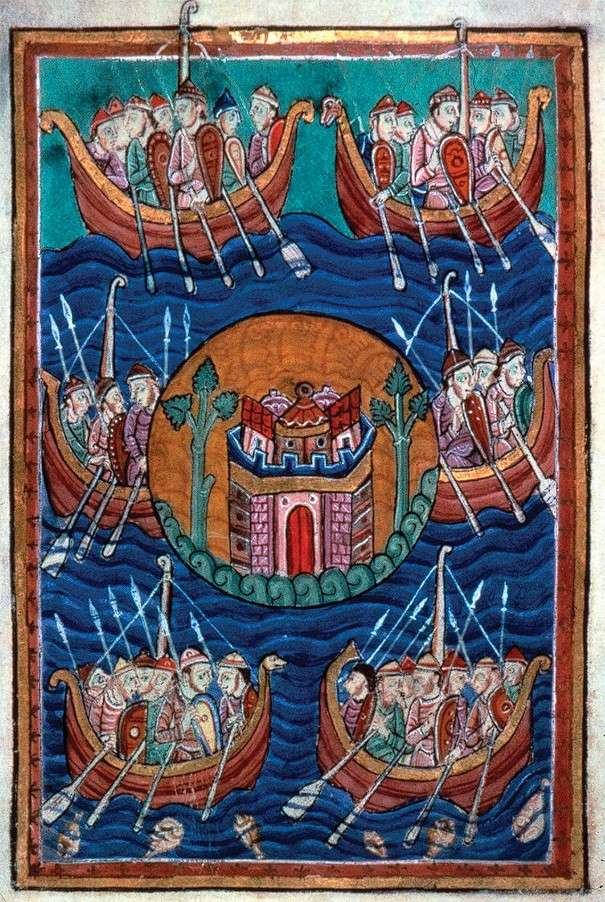
Illuminated manuscript depicting the Danish invasion of England, Ivar the Boneless with his brothers Halfdan and Ubbe.
The Viking Age did not appear out of nowhere. The people we now call “Vikings” had deep roots in the rugged landscapes of Scandinavia, shaped over millennia by climate, geography, and a long tradition of craftsmanship, warfare, and seafaring. Understanding the Viking Age requires looking at what came before — the slow evolution of society in the North, from the Stone Age to the early medieval kingdoms.
I. Prehistoric Scandinavia: Survival, Stone Tools, and Migration (c. 10,000 – 1800 BCE)
At the end of the last Ice Age (around 10,000 BCE), as the glaciers retreated, humans began to migrate into what we now call Scandinavia — first into Denmark and southern Sweden, and later into Norway and inland regions. These Mesolithic communities were hunter-gatherers, skilled in fishing, boat-making, and tracking large game like elk and reindeer.
During the Neolithic period (c. 4000–1800 BCE), farming techniques gradually arrived from the south, though the harsh northern climate meant that fishing and hunting remained important. Megalithic tombs, rock carvings, and stone axes show that communities were becoming more organized and ritual-focused.
II. The Nordic Bronze Age (c. 1800–500 BCE)
The Bronze Age in Scandinavia was marked by increased trade with Central Europe and the Mediterranean. Although Scandinavia had no native copper or tin (necessary for making bronze), the region became part of long-distance trade routes, exchanging furs, amber, and hides for metal.
This period left behind striking archaeological evidence: large burial mounds, rock carvings (petroglyphs), and decorated bronze items such as swords and spiral brooches. The prevalence of ships in petroglyphs from Sweden and Norway suggests an early cultural and spiritual emphasis on seafaring.
III. The Iron Age and the Emergence of Norse Identity (c. 500 BCE – 800 CE)
The transition to the Iron Age brought better weapons and tools, supporting a growing population. From about 500 BCE to 400 CE, Scandinavian society remained tribal, with local chieftains and warrior elites competing for influence. Burial finds from this period show increasing social stratification, as elite graves were furnished with weapons, imported goods, and elaborate jewelry.
During the Migration Period (c. 400–600 CE) — when Germanic tribes moved south into the Roman Empire — many Scandinavians remained behind, but they were clearly influenced by contacts with the south. This is the time when Norse mythology began to take more organized form, as tribal oral traditions developed into complex cosmologies centered around gods like Odin, Thor, and Frey.
The Vendel Period (c. 550–800 CE), named after rich burial finds in Sweden (such as Vendel and Valsgärde), shows a society increasingly organized around warrior culture. Elaborate helmets, swords, and decorated ships reflect a heroic ethos and ritualized warfare. By this time, many of the social and religious structures that would define Viking culture were already in place.
IV. The Beginning of the Viking Age (793 CE)
The Viking Age is traditionally dated to begin in 793 CE, with the attack on the Christian monastery at Lindisfarne, off the northeast coast of England. It was not the first Scandinavian raid, but it was the first widely recorded in European sources, and it marked the start of nearly three centuries of Norse expansion.
This expansion was driven by multiple factors:
- Demographic pressure and limited arable land
- Political centralization under emerging kings and jarls
- Maritime innovation, especially the longship
- Trade and wealth found in foreign ports and monasteries
From this point forward, Viking ships began appearing along the coasts of Ireland, Scotland, the Frankish kingdoms, the Baltic shores, and eventually into the rivers of Eastern Europe.
V. Key Viking Expeditions and Dates
- 793: Raid on Lindisfarne (Northumbria, England)
- 795–830s: Attacks on Ireland and the Scottish isles
- 840: Norse settlement at Dublin founded
- 865: The “Great Heathen Army” lands in England, beginning a large-scale war of conquest
- 874: Settlement of Iceland begins (according to Landnámabók)
- 911: Rollo, a Viking chieftain, is granted land in Normandy by the Frankish king
- 950s–1000: Norse exploration of Greenland and Vinland (North America)
- 1066: End of the Viking Age, marked by the defeat of Harald Hardrada at Stamford Bridge (England)
VI. Beyond the Raids
While the Viking Age is often defined by raids and warfare, the period also saw the development of legal codes, permanent settlements, runic inscriptions, and international trade networks. Norse culture influenced regions far beyond Scandinavia, from Ireland to the Byzantine Empire.
By the end of the Viking Age in the 11th century, the Scandinavian kingdoms had converted to Christianity, and centralized monarchies began to replace the old tribal systems. But the legacy of the Viking world — its mythology, seafaring tradition, and distinctive art — continues to fascinate us today.
Algizrune Art – Historical Jewelry Makers — storytellers, artists, and whispers of the ancestors